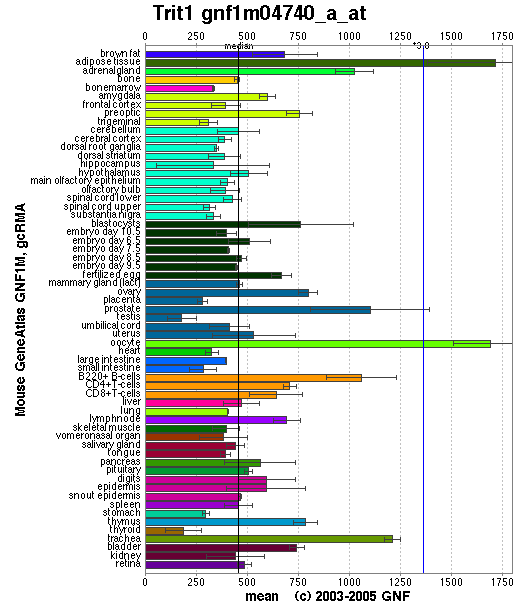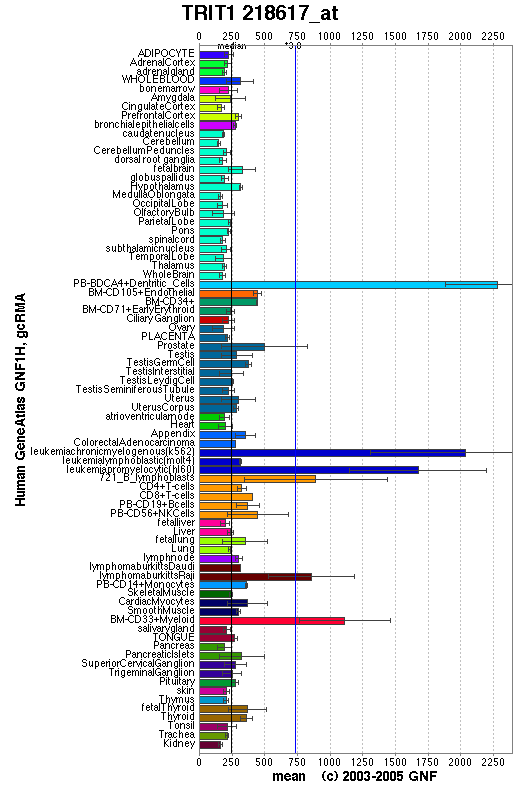Functional analysis of 2qgn: Difference between revisions
No edit summary |
No edit summary |
||
| Line 4: | Line 4: | ||
[[Image:Human geneAtlas.png]] | [[Image:Human geneAtlas.png]] | ||
Transferases are enzymes which transfer a group from a donor molecule to an acceptor molecule. Thus, tRNA isopentenyltransferases (IPT) are enzymes that transfer an isopentenyl group to a tRNA molecule and this functions to catalyse the biosynthesis of cytokinins. Cytokinins are tRNA molecules containing modified adenine found at position 37 of the tRNA. An anticodon binding to codon encoding for uridine is found next to this modified adenine. This means that this modification occurs at the acceptor stem of tRNA molecules.This detailed and precise adenine modification is important in maintaining correct framework and the subsequent translation pathway. | |||
Cytokinins are involved in several biochemical and cellular processes such as cell division and growth, both in plants and animals. They can exist in two forms; the tRNA-free and the tRNA-bound form, through addition of adenine to tRNA or AMP acceptor molecules. As the name suggest, tRNA-IPT adds adenine to tRNA molecules specifically to tRNA which binds to the codon encoded with uridine. | Cytokinins are involved in several biochemical and cellular processes such as cell division and growth, both in plants and animals. They can exist in two forms; the tRNA-free and the tRNA-bound form, through addition of adenine to tRNA or AMP acceptor molecules. As the name suggest, tRNA-IPT adds adenine to tRNA molecules specifically to tRNA which binds to the codon encoded with uridine. | ||
| Line 15: | Line 15: | ||
The C2-H2 Zinc finger motif found in tRNA-IPT also contributes to the enzyme's function. This motif is commonly found in nucleic acid-binding proteins and is composed of 25 to 30 amino acid residues. | The C2-H2 Zinc finger motif found in tRNA-IPT also contributes to the enzyme's function. This motif is commonly found in nucleic acid-binding proteins and is composed of 25 to 30 amino acid residues. | ||
A schematic representation of a zinc finger domain is shown below: | |||
x x | x x | ||
x x | x x | ||
| Line 28: | Line 28: | ||
C H | C H | ||
x x x x x x x x x x | x x x x x x x x x x | ||
http://ca.expasy.org/cgi-bin/nicedoc.pl?PDOC00028 | http://ca.expasy.org/cgi-bin/nicedoc.pl?PDOC00028 | ||
The biological process of tRNA-IPT is trna metabolism. Generally, tRNAs are RNA molecules which is involved protein synthesis. They carry amino acids which corresponds to their anti-codon recognition sequence and adds them to the complementary codons along the length of the mRNA. | |||
Revision as of 10:17, 21 May 2008
Transferases are enzymes which transfer a group from a donor molecule to an acceptor molecule. Thus, tRNA isopentenyltransferases (IPT) are enzymes that transfer an isopentenyl group to a tRNA molecule and this functions to catalyse the biosynthesis of cytokinins. Cytokinins are tRNA molecules containing modified adenine found at position 37 of the tRNA. An anticodon binding to codon encoding for uridine is found next to this modified adenine. This means that this modification occurs at the acceptor stem of tRNA molecules.This detailed and precise adenine modification is important in maintaining correct framework and the subsequent translation pathway.
Cytokinins are involved in several biochemical and cellular processes such as cell division and growth, both in plants and animals. They can exist in two forms; the tRNA-free and the tRNA-bound form, through addition of adenine to tRNA or AMP acceptor molecules. As the name suggest, tRNA-IPT adds adenine to tRNA molecules specifically to tRNA which binds to the codon encoded with uridine. Below is the reaction catalysed by tRNA isopentenyltransferase.
Isopentenyl diphosphate + tRNA <=> diphosphate + tRNA containing 6-isopentenyladenosine
reaction taken from http://www.expasy.org/cgi-bin/nicezyme.pl?2.5.1.8
The C2-H2 Zinc finger motif found in tRNA-IPT also contributes to the enzyme's function. This motif is commonly found in nucleic acid-binding proteins and is composed of 25 to 30 amino acid residues.
A schematic representation of a zinc finger domain is shown below:
x x
x x
x x
x x
x x
x x
C H
x \ / x
x Zn x
x / \ x
C H
x x x x x x x x x x
http://ca.expasy.org/cgi-bin/nicedoc.pl?PDOC00028
The biological process of tRNA-IPT is trna metabolism. Generally, tRNAs are RNA molecules which is involved protein synthesis. They carry amino acids which corresponds to their anti-codon recognition sequence and adds them to the complementary codons along the length of the mRNA.

